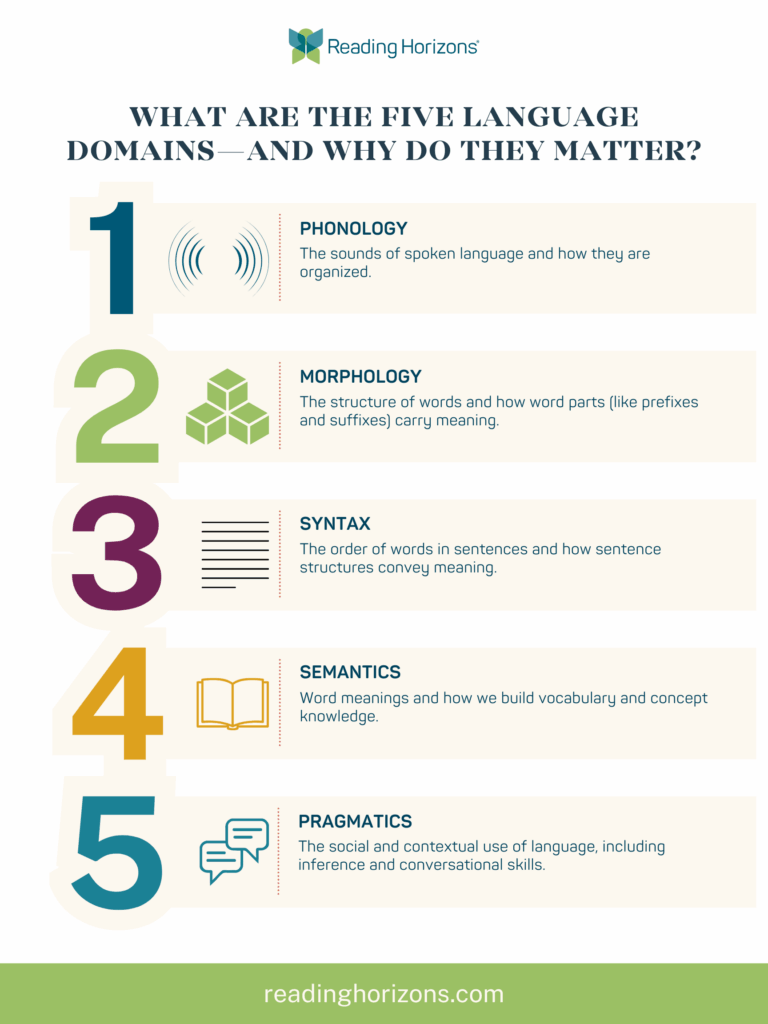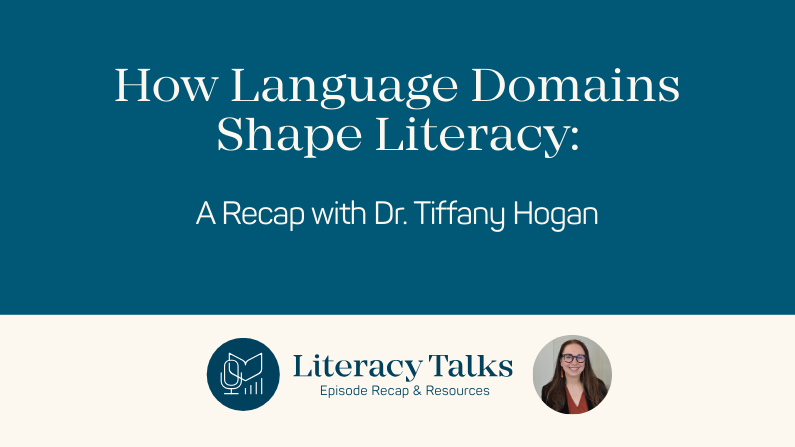Why Language Domains Matter in Literacy Instruction
In this episode of Literacy Talks, Dr. Tiffany Hogan joins the hosts to explore one of the most essential but often overlooked aspects of literacy: the five language domains—phonology, morphology, syntax, semantics, and pragmatics. These domains form the foundation of how we understand, use, and teach language—and are central to effective literacy instruction.
This episode is packed with practical examples, research-backed insights, and encouragement for educators looking to deepen their understanding of how oral language fuels reading and comprehension.
What Are the Five Language Domains—and Why Do They Matter?
Dr. Hogan explains each domain with clarity:
- Phonology – The sounds of spoken language and how they are organized.
- Morphology – The structure of words and how word parts (like prefixes and suffixes) carry meaning.
- Syntax – The order of words in sentences and how sentence structures convey meaning.
- Semantics – Word meanings and how we build vocabulary and concept knowledge.
- Pragmatics – The social and contextual use of language, including inference and conversational skills.
Each domain plays a critical role in language development and literacy success, and they often overlap in complex ways that impact student learning.
Real-Life Classroom Connections to Language Development
Educators will recognize the everyday relevance of these domains—from helping students with irregular past tense verbs to supporting sentence construction and vocabulary depth. The conversation offers relatable stories, such as a classroom moment involving the Louisiana Purchase and syntax confusion, showing just how nuanced language instruction can be.
Dr. Hogan and the hosts also emphasize how awareness of these domains can empower teachers to support students more confidently, even when instruction gets complex.
Understanding Neurodiversity in Language Learning
A key takeaway from the episode is the importance of neurodiversity in language learning. Dr. Hogan discusses how students with dyslexia, developmental language disorder (DLD), and social communication difficulties may struggle in different domains—and how knowing the source of these struggles helps tailor support.
Importantly, she encourages educators to shift from a “fix it” mindset to one focused on creating supportive learning environments that embrace diversity in how children acquire and use language.
Why Teachers Need Systemic Support, Not Just Training
Dr. Hogan makes a powerful case for systemic change: instead of relying solely on teacher knowledge, schools must implement structures that support both word reading and language comprehension—in tandem and from early grades onward.
She points out that while tools like MTSS and screening exist for word reading, similar systems are still developing for oral language. Teachers need tools, resources, and collaborative partnerships (especially with SLPs) to fully meet the needs of all learners.
Bridging Research and Practice in Literacy Instruction
From citing recent studies to mentioning her work on the Reading for Understanding Initiative, Dr. Hogan explains how research has shown the importance of teaching language explicitly—and how essential it is that curriculum materials reflect this knowledge.
She also shares a hopeful vision for bridging gaps between speech-language pathologists, classroom teachers, and administrators so that instruction becomes more cohesive and impactful.
Supporting Language Development in All Learners
The hosts reflect on how understanding language domains helps support students who may not qualify for special services but still need oral language support in the classroom. Dr. Hogan affirms that language is not a constrained skill—it can be nurtured across a lifetime with the right strategies and instruction.
Teaching the Language Domains in Real Classrooms
For teachers wondering what to do next, Dr. Hogan recommends starting with awareness, using tools like AI for just-in-time support, and finding ways to co-learn with students. She also shares optimism about new tools and curricula that integrate language development more thoroughly and accessibly.
Helpful Links from Dr. Hogan and the Literacy Talks Team
Here are some of the key resources and references from the episode:
- The SAiL Literacy Lab – Dr. Hogan’s research lab
- Reading for Understanding Initiative Resources
- Cascade Reader – Syntactic comprehension support
- Julie Van Dyke and IDA’s special issue on Syntax
- Big Sky Literacy Summit
- Cubed Language Assessment
- OxEd and Assessment
- Speech to Print by Louisa Moats
- Fact sheets for DLD screening
- DLD screening: A Review of Screeners to Identify Risk of Developmental Language Disorder | American Journal of Speech-Language Pathology
- Let’s Know! Curriculum: Curriculum – Language and Reading Research Consortium
- Reading for Understanding Research Initiative
- Language Domains Infographic!


